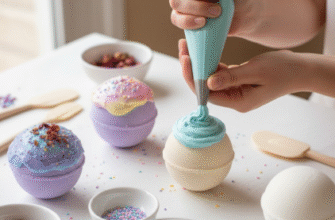Ever scooped up a dollop of lusciously thick, creamy, foaming bath whip at a boutique bath and body store and thought, “I wish I could make this”? Well, guess what? You absolutely can! Diving into the world of DIY bath products might seem daunting, but creating your own foaming bath whip base is a surprisingly achievable and incredibly rewarding project. It’s like building the perfect blank canvas, ready for you to splash with your favourite colours, scents, and textures. Forget settling for generic store-bought options; let’s get hands-on and craft a base that’s uniquely yours.
This base is the foundational magic behind those delightful whipped soaps, sugar scrubs, and shaving creams. Think of it as the starting point, the core recipe that provides the cleansing power and that signature airy, marshmallow-like texture. Once you master the base, the possibilities for creating finished products are virtually endless. It’s your gateway to personalized pampering!
So, What Exactly Is This Fluffy Stuff?
A foaming bath whip base, sometimes called whipped soap base or foaming bath butter base, is essentially a semi-solid, whippable soap. It’s formulated with surfactants (the cleansing and bubbling agents), humectants (like glycerin to draw moisture), and usually some kind of thickener or fatty acid (like stearic acid) to give it that dense, scoopable, yet light texture when whipped. Unlike traditional cold-process or melt-and-pour soap, this base is specifically designed to be easily whipped up, incorporating air to achieve that distinctive fluffy consistency. It cleanses effectively but is often formulated to be gentler and more moisturising than some bar soaps, making it feel luxurious on the skin.
Why Bother Making Your Own Base?
Sure, you can buy pre-made foaming bath whip bases, and they work great. But where’s the deep satisfaction in that? Making your own offers several fantastic advantages:
- Ingredient Control: You know exactly what’s going into your product. Want to ensure it only uses plant-derived surfactants? Need to avoid a specific ingredient due to sensitivities? Making it yourself gives you complete oversight.
- Cost-Effectiveness: While there’s an initial investment in ingredients, making larger batches of base yourself can often be significantly cheaper per ounce compared to buying pre-made tubs, especially if you get hooked on crafting!
- Learning Experience: You gain a deeper understanding of how bath products are formulated. Knowing the role of each ingredient empowers you to troubleshoot and customize more effectively down the line.
- Ultimate Customization: Even the base itself can be tweaked slightly once you’re comfortable. Want a firmer base? A slightly softer one? You can experiment (carefully!) with ratios.
- The Fun Factor: Let’s be honest – it’s incredibly fun! There’s a certain kind of alchemy in transforming raw ingredients into a beautiful, usable product. It’s creative, hands-on, and results in something you can proudly use or gift.
Gathering Your Tools and Ingredients
Alright, let’s get down to business. To create your foaming bath whip base, you’ll need a few key things. Precision is important in bath product making, so using a digital scale that measures in grams is highly recommended for consistent results.
Essential Ingredients:
- SCI Noodles/Powder (Sodium Cocoyl Isethionate): This is a very popular, gentle, coconut-derived surfactant. It provides lovely, dense lather and cleansing. Noodles are often easier to handle than the fine powder (which can become airborne). This is our primary cleanser and foamer.
- Distilled Water: Using distilled water is crucial to avoid introducing minerals or impurities found in tap water, which can affect the final product and its preservation. This dissolves the SCI and other ingredients.
- Glycerin (Vegetable Glycerin): A fantastic humectant, meaning it draws moisture to the skin, making the base feel more hydrating. It adds moisturizing properties and contributes to the texture.
- Cocamidopropyl Betaine (CAPB): A secondary surfactant, often used alongside SCI. It boosts foam, improves viscosity (thickness), and adds mildness. Enhances bubbles and thickens slightly.
- Stearic Acid: A vegetable-derived fatty acid. It acts as a thickener and hardener, giving the base its structure and contributing to a stable, creamy lather. This is key for the solid, scoopable texture.
- Broad-Spectrum Preservative: Absolutely essential! Because this recipe contains water, a preservative is needed to prevent the growth of bacteria, mold, and yeast. Choose one suitable for rinse-off cosmetic products (like Optiphen Plus, Liquid Germall Plus, or similar – research recommended usage rates for your specific choice). Keeps your base safe to use.
Essential Equipment:
- Digital Scale (measuring in grams)
- Heat-Resistant Beakers or Bowls (at least two)
- Double Boiler or Saucepan with Water (for gentle heating)
- Hand Mixer or Stand Mixer (with whisk attachments)
- Spatulas
- Thermometer (optional, but helpful)
- Safety Goggles
- Gloves
- Dust Mask (especially if using powdered SCI)
- Clean Jars or Containers for storage
Safety First! Always wear safety goggles and gloves when handling soap-making ingredients, especially surfactants like SCI which can be irritating in raw form (particularly the powder if inhaled). Work in a well-ventilated area. Hot ingredients require careful handling to prevent burns.
A Basic Foaming Bath Whip Base Recipe
This recipe provides a solid starting point. Remember, measurements by weight (grams) are far more accurate than volume (cups/spoons) in cosmetic crafting.
Ingredients (Example Ratios by Weight):
- 400g SCI (Sodium Cocoyl Isethionate – noodles preferred)
- 250g Distilled Water
- 200g Glycerin
- 100g Cocamidopropyl Betaine (CAPB)
- 50g Stearic Acid
- 5-10g Preservative (check manufacturer’s recommended rate for your chosen preservative, typically 0.5% – 1.0% of the total batch weight)
Total Batch Weight: Approximately 1000g (plus preservative)
Step-by-Step Instructions:
- Prepare Your Workspace: Clean and sanitize your tools and containers. Put on your safety gear (goggles, gloves, mask if using SCI powder).
- Heat Phase: In one heat-resistant beaker/bowl, combine the Distilled Water, Glycerin, and SCI. In a separate heat-resistant beaker/bowl, place the Stearic Acid.
- Gentle Melting: Place both beakers in a double boiler or a saucepan with a few inches of simmering (not boiling) water. Heat gently, stirring the SCI mixture occasionally, until the SCI is mostly dissolved and the Stearic Acid is fully melted. This can take some time (20-30 minutes or more), especially for the SCI. Don’t rush it with high heat, as this can scorch ingredients. Aim for temperatures around 70-75°C (160-167°F).
- Combine: Once both phases are fully melted/dissolved and roughly at the same temperature, carefully pour the melted Stearic Acid into the SCI/Water/Glycerin mixture. Stir well to combine.
- Add Betaine: Remove from heat. Stir in the Cocamidopropyl Betaine. The mixture might thicken slightly.
- Cool Down: Allow the mixture to cool. Stir it occasionally as it cools to prevent the stearic acid from solidifying unevenly on top. You want it to cool to around 40-45°C (104-113°F) before adding the preservative and whipping. This temperature is usually ideal for incorporating heat-sensitive preservatives and achieving a good whip.
- Add Preservative: Once cooled to the appropriate temperature (check your specific preservative’s guidelines, but below 50°C is common), add your chosen broad-spectrum preservative. Stir thoroughly to ensure it’s evenly distributed.
- Whip It Good: Now for the fun part! Using your hand mixer or stand mixer (with whisk attachment), start whipping the mixture on low speed, gradually increasing to medium-high. It will start to lighten in colour and increase in volume. Keep whipping! This process can take anywhere from 10 to 20 minutes, sometimes longer depending on your mixer and the temperature. Be patient. You’re looking for it to become thick, white, and fluffy, holding soft peaks like meringue or whipped cream. Don’t overwhip to the point where it becomes overly stiff or dry.
- Package: Once you’ve reached the desired fluffy consistency, scoop the finished foaming bath whip base into clean, airtight containers. Label them clearly with the name and date made.
Understanding Your Ingredients Better
Surfactants: The Bubble Makers
SCI (Sodium Cocoyl Isethionate) is the star here. It’s an anionic surfactant known for being mild and creating a creamy, stable lather. It comes from coconut oil and is biodegradable. While gentle, the powder form is very fine and easily inhaled, hence the recommendation for noodles and a dust mask. Cocamidopropyl Betaine (CAPB) is an amphoteric surfactant, meaning it can act as either an acid or a base. It works synergistically with SCI to create more voluminous bubbles, thicken the mixture, and reduce potential irritation, making the final product feel milder on the skin.
Liquids: Hydration and Dissolving Power
Distilled Water is the solvent; it dissolves the SCI and allows the other ingredients to incorporate properly. Using anything other than distilled or deionised water risks introducing contaminants or minerals that could spoil the batch or cause unwanted reactions. Glycerin is a powerful humectant. It draws moisture from the air towards the skin, helping to counteract any potential drying effect from the surfactants and leaving the skin feeling soft and hydrated.
Thickeners and Stabilizers
Stearic Acid is a waxy fatty acid found naturally in vegetable fats. In this recipe, it’s crucial for thickening the base into a semi-solid state when cool. It also helps stabilize the lather, making the bubbles richer and longer-lasting. Without it, the base would likely be too liquid.
The Non-Negotiable: Preservative
Any product containing water (like this base) is a potential breeding ground for bacteria, yeast, and mold. Using a preservative is not optional; it’s essential for safety. An unpreserved product can grow nasty microbes within days or weeks, even if it looks and smells fine. Choose a broad-spectrum preservative effective against all types of microbial growth and follow the manufacturer’s instructions regarding usage rate and incorporation temperature.
Preservation is Key! Always use a reliable broad-spectrum preservative in any water-containing cosmetic formulation, including this base. Ensure you use it at the correct percentage recommended by the supplier for rinse-off products. This ensures your handmade creations remain safe to use for their intended shelf life.
Unleashing Your Creativity: Customizing the Base
Now that you have your beautiful, fluffy base, the real fun begins! This base is designed to be customized *after* it’s made, usually by taking a portion and whipping in your desired additives. Here are some ideas:
- Fragrance: Add cosmetic-grade fragrance oils or essential oils. Start with a low percentage (around 0.5% to 1% of the portion you’re customizing) and mix well. Always check the safe usage rates for the specific oil you are using, especially for skin products.
- Colour: Use skin-safe micas or liquid colorants. Add a tiny amount at a time and whip it in until you achieve the desired shade. Micas add shimmer, while liquid dyes provide vibrant hues.
- Exfoliation (Sugar/Salt Scrubs): Gently fold in sugar or fine salt (at roughly a 1:1 or up to 2:1 ratio of exfoliant to base by weight) for an instant foaming scrub. Don’t overmix, or you might deflate the whip. You can also add finer exfoliants like jojoba beads or ground oatmeal.
- Extra Moisture: You can incorporate small amounts (e.g., 1-3% of the portion weight) of skin-loving oils (like sweet almond, jojoba, avocado) or butters (like shea or mango butter, melted and cooled slightly). Be aware that adding too much oil/butter can decrease the lather and potentially deflate the whip slightly, so start small.
- Clays: Small amounts of cosmetic clays (kaolin, bentonite) can be added for colour, slip, and mild detoxifying properties. Ensure they are well dispersed to avoid clumps.
When customizing, work with smaller portions of your base initially until you get a feel for how different additives affect the texture and performance.
Troubleshooting Common Foaming Bath Whip Issues
- Whip isn’t Fluffy: This could be due to several factors. The mixture might have been too warm or too cold when whipping. Under-whipping is common – it often takes longer than you think! Conversely, over-whipping can sometimes make it grainy or too stiff. Ensure your ingredients (especially stearic acid) were fully melted and incorporated.
- Base is Too Hard or Too Soft: This usually points to ingredient ratios. Too much stearic acid can make it very hard; too little can make it soft or runny. Ensure your measurements were accurate (using a scale!). Temperature during cooling and whipping also plays a role.
- Weeping or Separation: If liquid separates out, it could be an issue with emulsification (ingredients not fully combined), incorrect temperatures during mixing, or sometimes incompatibility with certain fragrance oils added later. Ensure thorough mixing at each stage. If adding oils/butters later, ensure they are incorporated well.
- Deflates After Adding Fragrance/Oil: Some fragrance oils or essential oils, as well as added liquid oils, can reduce the fluffiness. Add them slowly and gently fold or whip them in on a low speed. Using less might be necessary.
Storing and Using Your Masterpiece
Store your completed foaming bath whip base in airtight containers in a cool, dark, dry place. Avoid getting water into the container, as this can compromise the preservative. The shelf life will largely depend on the preservative used and its efficacy, but typically, a well-preserved base can last 6-12 months or longer. Always check for any signs of spoilage (odd smell, change in colour or texture, visible growth) before use.
To use the base, simply scoop out the desired amount, place it in a mixing bowl, and whip in your chosen colours, fragrances, exfoliants, or oils as described in the customization section. Then, package your finished product (whipped soap, scrub, etc.) in appropriate jars or tubs.
Ready to Whip Up Some Fun?
Creating your own foaming bath whip base is a journey into the heart of bath product crafting. It’s a process that combines a bit of science with a lot of creativity. There’s immense satisfaction in taking raw ingredients and transforming them into a luxurious, fluffy base ready for endless possibilities. Don’t be afraid to experiment (safely, of course!) once you’ve mastered the basics. Embrace the process, enjoy the learning curve, and get ready to elevate your bath time routine with creations that are truly, uniquely yours. Happy whipping!








